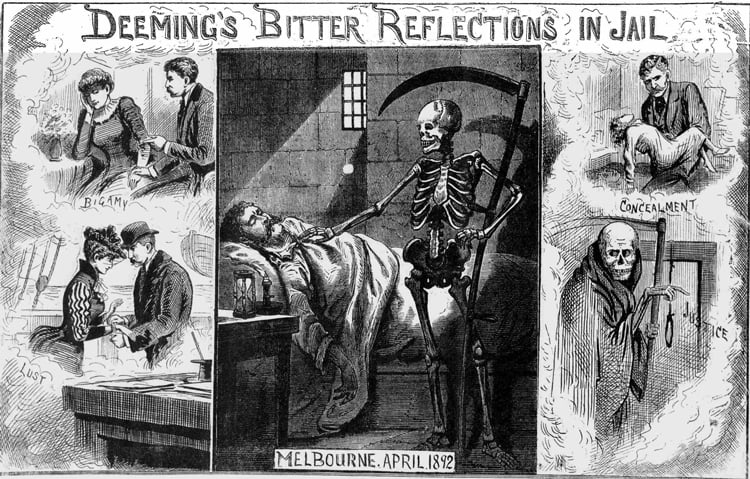Over the Christmas period 1891, Frederick Bailey Deeming (1853 – 1892) murdered his wife, Emily Mather, at a house they were renting in the Windsor suburb of Melbourne, Australia.
Ultimately, he would be convicted and executed for this crime, but, initially, the fact that he had murdered Emily was not readily apparent, since he immediately fled the rented property.
In March, 1892, a prospective tenant went to view the house, and complained of a disagreeable odour.
The owner, on raising the hearthstone of the house in search of the source of the smell, was fair-near felled by the foul stench that emanated from beneath it.
The police were called and Emily Mather’s body was discovered.
Deeming was arrested at Southern Cross, Western Australia, on 12th March 1892.
HE CONFESSED TO THE WHITECHAPEL MURDERS
Whilst in custody, he also confessed to having murdered his first wife, Marie James, at their house in Rainhill, Merseyside, England, in 1891; and then he caused a sensation by also confessing to having carried out several of the Whitechapel Murders.
When news of this latter confession broke, the English papers began exploring his possible connection to the crimes, and several began comparing his description to those given by various witnesses who may have seen the face of Jack the Ripper.
One such paper was The Illustrated Police News :-
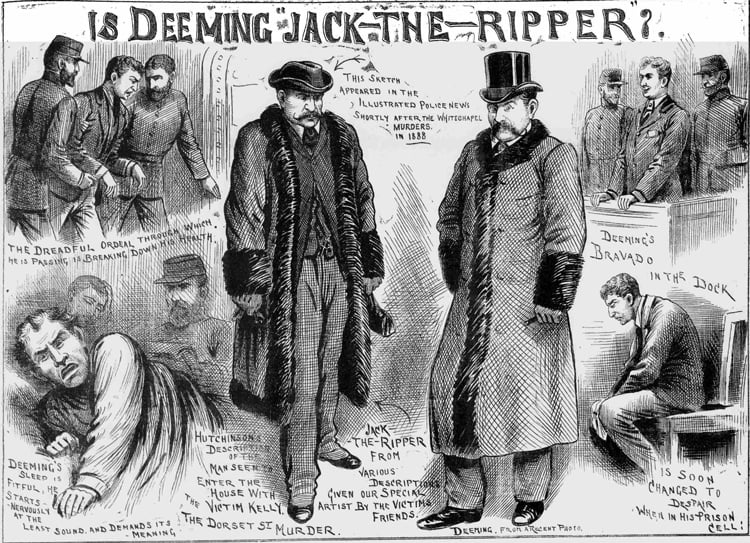
EXTRAORDINARY TELEGRAMS.
Lloyd’s Weekly Newspaper had already provided its readers with the lurid details of Deeming’s career, and of the Australian murder, in its edition of Sunday 27th March 1892:-
“Yesterday morning great excitement was created in London by the publication of the following telegram, sent out by Dalziel’s agency :-
“PERTH (Western Australia), Saturday. – Deeming has made a clean breast of it to his solicitor.
He has confessed to the Rainhill murder and to the last two Whitechapel murders, but says he knows nothing about the other “Jack the Ripper” crimes. Dalziel.”
Reuter sent a further despatch :-
“MELBOURNE, Saturday. – The Argus to-day states that Deeming has confessed to a Perth official that he is guilty of the Rainhill murders, and committed the two last Whitechapel murders.”
He is reticent, however, with regard to the murder charged against him at Windsor, and in this case appears to rely for his defence upon the statement that his wife was seen alive in Melbourne on December 29, whereas the date of the Windsor crime is alleged to have been December 24.
Deeming asserts that the unfortunate woman eloped with another man.
There is considerable difficulty in fixing on the two murders referred to.
THE WHITECHAPEL MURDERS VICTIMS
Ordinarily nine women are reckoned as victims of “The Ripper,” the following being the dates:-
1. Emma Elizabeth Smith, aged 45, was found dead on Easter Tuesday, April 3, 1888, near Osborn-street, having been killed by a stake or iron instrument being thrust through her body.
2. Martha Tabram, aged 35, was found dead in a passage in George-yard-buildings. Commercial-street, on August 7, 1888. She had teen stabbed in 39 different places upon the body.
3. Mary Ann Nicholls, living apart from her husband, was found dead early in the morning in Buck’s-row. Her throat was cut to such an extent that she was nearly decapitated, and the abdomen was ripped open by a knife. Date of murder, August 31, 1888.
4. Annie Chapman, aged 47, was found shortly after daybreak of September 8, 1888, in a back yard behind Hanbury-street. Her throat had been cut, an attempt had been made to cut off the head, the body eviscerated, and stabbed several times on each side. The womb had been removed and was missing.
5. Elizabeth Stride, whose husband was drowned in the Princess Alice disaster, was found with her throat cut, on September 30, 1888, inside the gateway of a yard in Berner-street, Whitechapel, leading to a club. The murderer was supposed to have been disturbed.
6. Catherine Eddowes, aged 44, was found on the same night, with her throat cut and body mutilated, in Mitre square, shorty after midnight. The body lay in a corner of the square. It was disembowelled, and in addition the womb and one kidney were taken away. The face was terribly cut. A portion of her apron, on which the murderer had wiped his hands, was found in Goulston-street.
7. Mary Jane Kelly, aged 24, was found murdered and mutilated in a room she occupied in a court off Dorset-street on Lord Mayor’s day, November 9, 1888. Her throat was cut, her breasts and entrails had been pulled out and put upon the table in the room, her face was scored on each side, the nose was slit, and the ears were almost lopped off. The flesh had also been removed from the top part of the legs and thighs, exposing the bones.
8. Alice McKenzie, an “unfortunate,” found murdered on the morning of July 17, 1888, in Castle-alley, off Whitechapel High-street. She was mutilated.
9. On February 13, 1891, an “unfortunate,” named Frames Coles, was found murdered under an archway leading from Swallow-gardens to Orman-street at, the foot of Leman-street. In this case there was no mutilation, though death had, as in the other instances, taken place through a deep wound in the throat. A sailor named Sadler was arrested, but proved an alibi.
Some include in the list the mutilated remains found under a railway arch on Sept. 10, 1889; but this was not a case of recent murder.
DID DEEMING MURDER ALICE MCKENZIE?
The Press association assumes that the first of the murders to which Deeming confesses was that of Wednesday, July 17, 1889.
The victim was Alice McKenzie, a woman of about 40. The woman’s throat was cut, and the body mutilated. The mutilation had not been carried out so savagely as in the preceding tragedies, and it was believed that the murderer had been disturbed in his fiendish work.
The scene of this crime was Castle-alley, within a quarter of a mile from the spot where former victims lost their lives, and the place had always borne an evil reputation.
It was a remarkable circumstance that the police. officers passed and re-passed the spot within a few moments of the perpetration of the crime, but in this, as in other cases, the murderer left no trace behind.
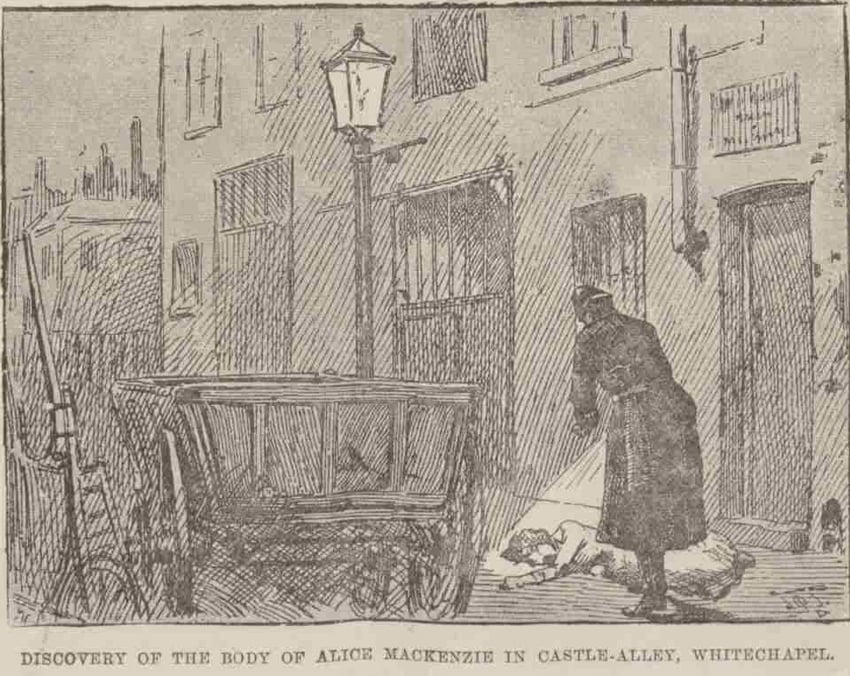
THE MURDER OF FRANCES COLES
The second of the two tragedies was on Feb. 13,1891. The victim was a woman named Frances Coles, and her body was discovered under an archway of the Great Eastern railway, leading from Swallow-gardens to Osborn-street. [sic]
A policeman came on the scene while the victim was still conscious, and he heard the sound of retreating footsteps, so that it was evident the murderer had had a very narrow escape.
The work of mutilation had not been so extensively carried out as in the case of the unfortunate woman McKenzie, but in cutting the throat of his victim the assassin had used such terrible force as to completely sever the spinal cord.
DEEMING IN HULL GAOL
It will be seen below that Deeming was in Hull gaol when Frances Coles was killed; but there is great doubt whether this crime was a “Ripper” tragedy.
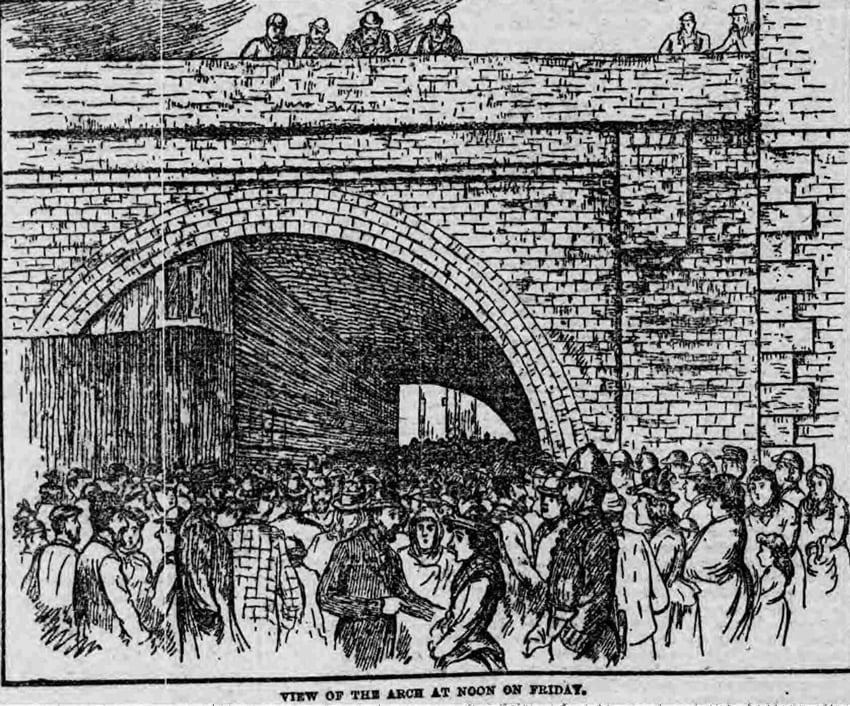
THE PRISONER’S CAREER.
The following is a record of the movements of the prisoner, under various names, so far as is known:-
FREDERICK BAYLEY DEEMING.
Born at Birkenhead and went to sea at an early age. Returned to his native town at the end of 1880.
1881. – Feb. – Married Miss Marie James at St. Paul’s church, Higher Tranmere. Went alone to Australia.
1882. – Joined by his wife. Sent to gaol for six weeks for theft at Sydney. Was then working as a plumber.
1884. – Numerous bank robberies took place in Sydney, the perpetrators not being detected.
1885. – More robberies, burglaries, mysterious disappearances, and tragedies.
1886. – Sets up shop in a large way, perpetrates a fraudulent bankruptcy, and absconds from Sydney.
1887. – Flies from Adelaide to Cape Town, after, it is stated, robbing two brothers, whom he met, of 60l.
1888. – Nothing known of him. DURING THIS YEAR SIX OF THE WHITECHAPEL MURDERS WERE PERPETRATED.
1889. – Passes in Durban as a mining engineer going to Johannesburg, and succeeds in obtaining 600l. by fraud.
June 1889. – Has 3,500l. advanced to him in Durban on bogus deeds, obtains 420l. worth of jewellery and decamps.
About the same time two murders were committed in the Transvaal, the murderer escaping.
July 17 1889. – THE EIGHTH WHITECHAPEL MURDER
Sept. 10 1889 – THE NINTH WHITECHAPEL MURDER
Sept. – Turned up unexpectedly in Birkenhead, where his wife was living.
Oct. – Is tracked by a private detective, who wants him for the Transvaal robberies, to Camberwell, then to Stockton-on-Tees, and back again to London.
Nov. – Sails on the Jumna for Australia. Leaving the vessel at Port Said, he doubles on his pursuers and returns to Birkenhead.
At this point Deeming took the alias of:-
“HARRY LAWSON.”
1890. – Jan – Leaves Birkenhead.
Feb. 18. – Arrives at Beverley and marries Miss Matheson a fortnight afterwards.
March 15. – Obtains jewellery by false pretences at Hull.
March 16. – Sails from Southampton for South America.
April 7. – Arrested at Monte Video.
Oct. 16. – Tried at Hull assizes, and sentenced to nine months’ imprisonment.
1891, July. 16. – Liberated from Hull gaol.
1891, July 19. – Miss Langley was murdered at Preston, near Hull, the murderer escaping.
He then assumed the alias of:-
“ALBERT OLIVER WILLIAMS.”
July 21, – Makes his appearance in Rainhill to inquire about Dinham Villa, and takes up residence at the Commercial hotel.
July 22 – Has tea at the hotel with a lady who turns out to be his wife, Mrs. Deeming, of Birkenhead.
July 23. – Lunches at the hotel with his wife, is afterwards accompanied to Huyton by Miss Mather, and signs the agreement of tenancy.
July 23. – The first barrel of cement supplied from St. Helens to Dinham Villa to the order of Miss Mather.
July 25. – Mrs. Deeming and four children arrive at Dinham Villa.
July 26-7. The five-fold murder is committed.
July 27 – Returns to the hotel.
July 30 – Obtains two more barrels of cement.
Aug 26. – “Williams” gives the Rainhill banquet.
Aug. 27. – Leaves Rainhill.
Sept. 22. – Marries Miss Emily Mather at Rainhill.
Oct. 17. – Sails with his wife from London to Australia
Nov. 27. – Miss Mather’s last letter posted on the way out, at Colombo.
Dec 15 – “Williams” and his wife arrive at Melbourne.
Dec. 24. – Miss Mather murdered.
He then took the alias of:-
“SWANSTON.”
1892, January. – Applied for another wife in a Melbourne matrimonial agency. Recognised in Sydney by a publican. Proposes to, and is accepted by Miss Rouncesvill, at Perth, Western Australia.
Feb. – Wrote to Miss Matheson at Beverley, repeating a previously-made request that she should rejoin him.
March 8. – Arrested at Southern Cross, on the eve of his marriage to Miss Rouncesvill.”
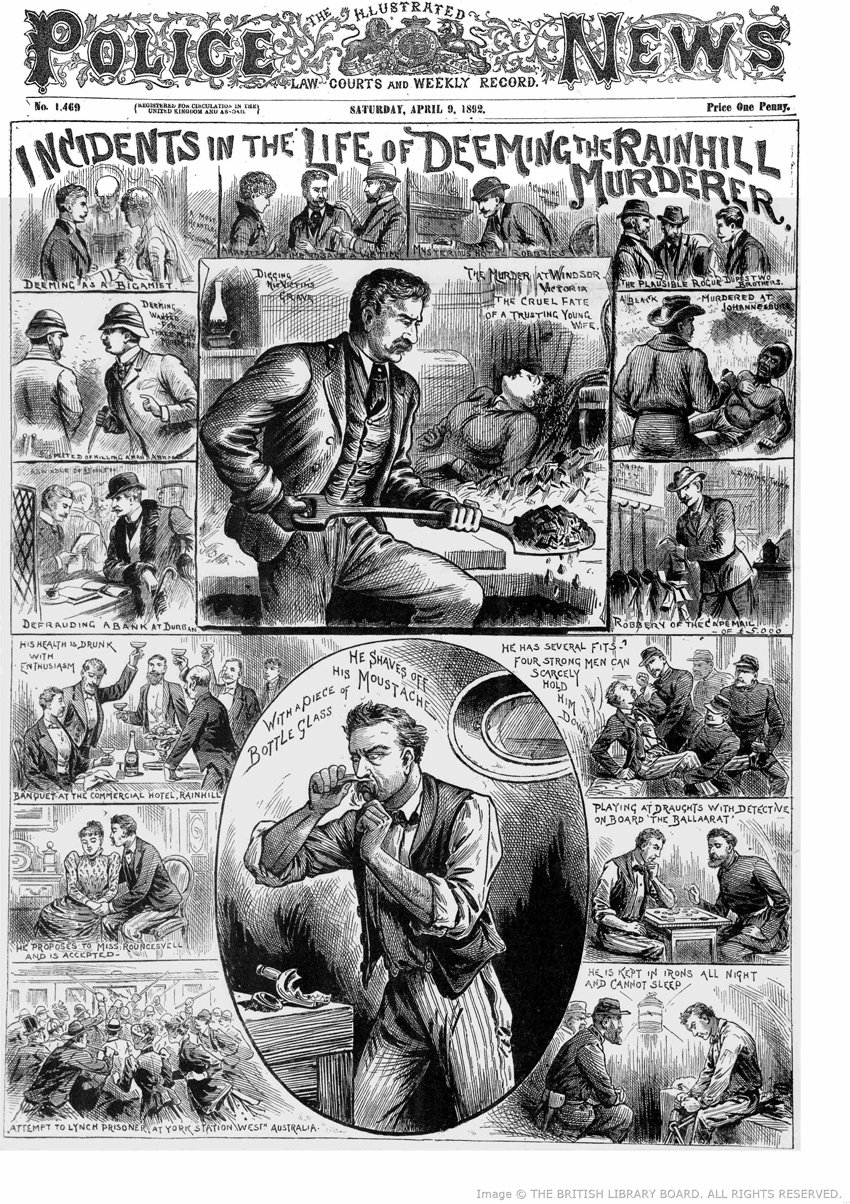
COMPARE HIS HANDWRITING
With Deeming languishing in his prison cell in Australia, the British press began looking into the possibility that he may have been responsible for the baffling series of crimes that had taken place in the East End of London.
Lloyd’s Weekly Newspaper, reported that they had had a visit from a former Metropolitan Police detective who had suggested an easy way of ascertaining the possibility of Deeming having carried out the Whitechapel Murders:-
“Mr. T. Cavanagh, a well-known official of former days at Great Scotland- yard, and an old reader of Lloyd’s, looked in at our office last night with a suggestion that appears to promise a ready way for the police to settle the “Jack the flipper” theory.
They are in possession of various letters, written in 1888, during the most fearful of the East-end atrocities, and it would be comparatively easy to compare them with the letters in the handwriting of Deeming obtained since his return in 1889.
These are said to be almost as clumsy and illiterate as some of the Whitechapel epistles, although the latter were purposely made more lurid by being in red ink, and in a straggling way.
It must be borne in mind that the correspondence from Rainhill is largely in the handwriting of Miss Mather, who acted as amauuensis for Deeming, almost from the commencement of their intimacy.”
Of course, it should also be remembered that few historians – and, for that matter, detectives at the time – believe, or believed, that the perpetrator of Whitechapel atrocities and the author, o authors, of any of the Jack the Ripper letters, were the same person, so it would appear that ex-detective Cavanagh’s suggestion would have proved of little use in connecting deeming to the crimes.
POLICE OFFICERS WERE GUARDED
Lloyd’s weekly Newspaper, then went on to give information about the enquiries that the police were making in England, or at least, as far as their reporters could glean about those enquiries, as the police were being extremely careful about what they revealed to the gentlemen of the press:-
“The detective and other officials of the police were very guarded yesterday in answering questions, but it has transpired that various officers have been making inquiries both in London and the provinces in reference to the Australian murder for the past three weeks.
That goes back at least a week before the arrest of Deeming at Southern Cross on March 8 led to the fact being cabled over and published in the London papers.
It may be that these inquiries relate to discoveries made by the Melbourne police in connection with the cemented floor at Windsor, in which Miss Mather’s body was concealed.”
THE POLICE WERE NOT CONVINCED
One thing that the police had revealed to the press, however, was that they were not in the least bit convinced by Deeming’s confession to the Jack the Ripper crimes. Lloyd’s duly noted the police’s reasons for not believing him:-
“At Scotland-yard yesterday the police authorities said they did not attach any importance to Deeming’s confession so far as the Whiteehapel murders are concerned.
The Superintendent of the Criminal investigation department states that it is his belief that the prisoner is endeavouring to bring about a remand at Melbourne in order that he may be brought over to England for trial.
Some of our readers may remember that for a week before the execution of Lefroy on Nov. 29, 1881, the prisoner confessed to a number of crimes, among them being the mysterious murder of Lieutenant Roper in Chatham barracks.
There was no foundation whatever for the self-accusations, which no doubt were made in the hope of prolonging his life by a few days or weeks for inquiries to be made.”
PRISONER’S JOURNEY
The newspaper article then revealed what was happening, and what was due to happen, to Deeming in Australia:-
“The prisoner Deeming is now on his way to Melbourne under a strong police escort.
All his luggage, the contents of which are of special importance in view the forthcoming trial, goes with him.
He will be embarked on board the P. and O. steamer Ballaarat when it calls at Albany, en route for Melbourne.
Deeming continues to affect perfect indifference as to the case against him. He has absolutely declined to allow himself to be photographed, and has made it impossible to obtain his likeness by this means.
Elaborate precautions are being taken to guard against any attempt to escape in the course of the voyage.
Cabins for himself and those in whose charge he will travel have been engaged on board the Ballaarat, and during the voyage Deeming will be closely confined, while he will also be manacled and kept under the strictest surveillance.
The Ballaarat is timed to reach Melbourne on April 3.
An Australian journalist in London informs us that Cawsey, the detective who was sent over to Perth after Deming, is one of the smartest and most intelligent in the colony.
Mr. Haynes, who has been defending the prisoner, is quite a young solicitor, but a member of the Legislature for Sydney, a brother of his being member for Sydney.
AUSTRALIAN SCENES
Windsor, the scene of Deeming’s second cement exploit, is a fashionable place close to St. Kilda, the nearest seaside suburb to Melbourne, but standing a little inland. It numbers about 2,500 inhabitants. The district is frequently flooded, but the town, fortunately for its existence, is built on a hill.
Windsor is one the oldest settled places in the colony, has several good business houses, many schools, and two fine bridges over the Hawkesbury river and the South Creek.
Southern Cross, where Deeming was arrested, is a small township of the Tilgarn or Tilgam goldfields, situated on the eastern borders of Western Australia, 220 miles east of Perth, and containing a population of 170 persons.
Many gold-mining companies are at work in this region, which, according to some, is likely to prove one of the richest provinces of the continent.
THE SOUTHERN CROSS PEARL
Romantic interest also attaches to the district from the fact that it was hereabouts that the Great Southern Cross pearl was found in 1884. It consists of nine pearls joined together in the form of a cross in which shape it was found by a man named Clarke, sold for 200l., and if now valued at 10,000l. It attracted a good deal of notice at the Colonial and Indian exhibition.
Deeming’s first act, after taking possession of a house in Southern Cross, was to purchase a barrel of cement, with which he had the floor of the main room cemented.
MATRIMONIAL FRAUDS
An Australian journalist writes that a few years ago a man, whose appearance tallies with the printed description of Deeming, victimised three or four ladies in New Zealand, by first marrying, and in some cases robbing, them, and afterwards deserting them.
He came over from Sydney in one of the Union Steamship Company’s boats, and in the course of a few months, visited nearly every city and town in that colony.
His modus operandi was both simple and rapid.
Having advertised for a wife with some means, setting out in the advertisement that he had himself 500l. a year, he would choose as his victim the applicant whom he considered to be possessed of the most money and property. In every case, at his insistence, the knot was tied quietly and unostentatiously, generally at a registry office in a town remote from the scene of his courtship and of his bride’s parental home.
HIS CHRISTCHURCH BRIDE
His first victim was the daughter of a clergyman – then in England – who lived with her sister in Christchurch.
He married this lady under the name of Delmare, but left her a week or so after the hymeneal ceremony had been performed.
During their short honeymoon he succeeded in inducing her to lend him the bit of money she had put by, ostensibly for the purpose of buying a business in Auckland.
He returned some weeks afterwards, not, however, to take her to the field of his business operations, but to inquire if she had yet “come into” the money which she had described in her letter before marriage as “great expectations from home,” for, he said, he had found that he wanted more capital than he had anticipated would be required.
Finding that there was nothing more to be made out of her, just then at all events, he deserted her, and she has never seen him since.
He left her a legacy, though, for, some time afterwards, she gave birth to an infant boy; and the love she in her guileless maidenhood bestowed on an errant and erring father is now wholly concentrated on an innocent child.
To the world she has given it out that she is a widow.
HIS WELLINGTON BRIDE
His next conquest was made in Wellington, where he married a young girl of 18 under another name.
This marriage took place during the short period that elapsed between his first and last visit to Christchurch, and when the Canterbury lady believed him to be purchasing a business in Auckland.
He disappeared from this city as suddenly and as mysteriously as he had come alter selling all the girl’s available jewellery and other property.
AN AUDACIOUS BIGAMIST
Two other cruel desertions are recorded against this audacious bigamist.
There is no doubt that he was last seen in Auckland, but whether he left for San Francisco or Sydney is not known.
It may be worthy of mention, in the light of recent discoveries, that contemporaneously with these bigamous events, several extensive hotel thefts were committed in various parts of New Zealand; and though he was not suspected at the time, the inference is now fairly admissible that he may possibly have divided his time between polygamous pursuits and “hotel barbering” exploits.
AT RAINHILL YESTERDAY
Large numbers of people arrived yesterday in Rainhill village, and the reported confession was being everywhere discussed.
Those who knew Deeming are not surprised at his confessing, as they say a great deal of his swagger was that of a cowardly bravado.
Deeming reappeared in Birkenhead in September, 1889.
To his acquaintances he frequently spoke of the Whitechapel murders.
Our representative learned that, before leaving Rainhill last year, the so-called “Williams” offered a bassinnette for sale to a Mrs. Cumming. She objected to the smell of chloride of lime, when he said it had been used to dispel the bad smells in the house, asking her if she did not perceive it.
Her answer was “No”; that the chloride of lime made her sick, and therefore she refused the article.
THE BEDFORD CHARGE
Our Bedford correspondent telegraphed last night:-
The police authorities at Bedford decline to give any definite information with reference to the alleged charge against Deeming for defrauding a Bedford gentleman.
The offence with which he was to be charged is supposed to be one of those committed at the Cape in 1889, and especially at Johannesburg.
Deeming, who represented himself to be a mining engineer, plundered several people to the extent of thousands of pounds, and when one of his victims came to live at Bedford he consulted the Chief-constable in order that the police generally might be on the look-out.
It also appears that the Chief constable does not hold a warrant, but, with other heads of police, he received Deeming’s photograph and other descriptive matter as to the man wanted.
The Bedford gentleman does not desire that his name should be brought into notoriety in connection with the case.”
ANOTHER JACK THE RIPPER LETTER
Lloyd’s Weekly Newspaper also reported that the news of Deeming’s confession had inspired another letter writer to compose another missive:-
“Our representative at Lambeth police-court yesterday sent word that the following letter, bearing the Peckham post-mark, and addressed “Mr. Hopkins, magistrate, Lambeth police-court, Kennington-lane,” had been received at the court:-
“Jack the Ripper. – I am about to commence my tricks about Cable and Flower and Dean streets. See if the bluecoats can have their eyes open. So look out.
This is no humbug.
I am the dreaded one of Whitechapel.”
The letter was unstamped, and twopence had to be paid upon it.”
THE EXECUTION OF DEEMING
Having been found guilty of the murder of Emily Mather, Deeming was sentenced to death.
He spent his last days writing his autobiography, and composing poetry in his cell.
He was hanged on the morning of the 23rd May 1892.
